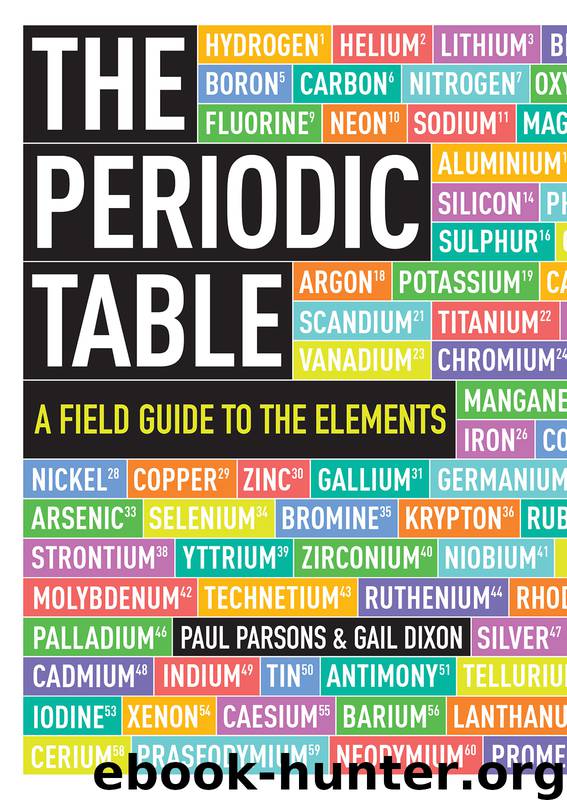The Periodic Table by Paul Parsons & Gail Dixon

Author:Paul Parsons & Gail Dixon [Parsons, Paul]
Language: eng
Format: epub, mobi
Publisher: Quercus
Published: 2014-03-24T16:00:00+00:00
Tellurium is a metalloid chemical element discovered in the late 18th century. It is used in the manufacture of DVDs, microchips and glass.
Iodine
* * *
Atomic number: 53 Category: halogen
Atomic weight: 126.90447 Melting point: 114 °C (237 °F)
Phase: solid Boiling point: 184 °C (364 °F)
Color: black Crystal structure: orthorhombic
* * *
Iodine is essential to human beings and many animals, as a key constituent of thyroxine and tri-iodothyronine. These are produced by the thyroid gland in the neck and regulate a number of metabolic functions, including controlling our body temperature and the levels of other hormones. A deficiency in iodine results in diseases such as goiter, which is characterized by a swollen neck (due to enlargement of the thyroid gland), and hypothyroidism, when the invalid feels tired and cold, gains weight and suffers from dry, itchy skin. A lack of iodine in pregnancy produces babies with a physical and mental condition known as cretinism.
If the body produces too much iodine, then hyperthyroidism results, with symptoms including restlessness, weight loss, heat intolerance and difficulty in concentrating. Severe deficiency in iodine can lead to impairment of intellectual and physical development, which was a particular problem in developing countries until the late 1990s, when health agencies ran campaigns to have table salt iodized.
Iodine in its natural form is toxic but, like other members of the halogen group, it forms a safe and stable ion, iodide, which is highly soluble and in plentiful supply in seawater. The element is isolated by acidifying brine and bubbling it through chlorine gas.
It’s important to note that often iodine is used as a blanket term when people are referring to its various forms. Elemental iodine is black, but most people associate the element with the violet tint that it produces when it vaporizes. It’s not surprising that its name is derived from this beautiful color, with its root in the Greek word iodes, meaning “violet.”
Iodine was discovered during the Napoleonic Wars, when British forces blockaded France to cut off supplies of saltpeter (potassium nitrate) needed for gunpowder. Bernard Courtois set up a business using seaweed ash collected from the coasts of Normandy and Brittany, which he boiled to extract potassium chloride. Experimenting one day, he added sulfuric acid to the residual liquid and was astonished to see a cloud of purple vapor rise. Samples of the chemical were submitted to the Institut Impérial de France and it was agreed that a new element had been found.
Iodine has a radioactive isotope, I-131, which was released into the atmosphere by the explosion at the Chernobyl nuclear power plant in 1986. This resulted in a huge rise in thyroid cancer in children living in contaminated areas. I-131 has a half-life of just eight days, but this was long enough to pass into the food chain via grazing animals and milk. More than 4,000 people contracted thyroid cancer among the 18 million who were exposed to the fallout. Treatment for this form of cancer has a high success rate; intriguingly, part of the process involves giving a dose of radioactive iodine to kill the cancer cells.
Download
The Periodic Table by Paul Parsons & Gail Dixon.mobi
This site does not store any files on its server. We only index and link to content provided by other sites. Please contact the content providers to delete copyright contents if any and email us, we'll remove relevant links or contents immediately.
Quantitative and Pattern Recognition Analyses of Five Marker Compounds in Raphani Semen using High-Performance Liquid Chromatography by Unknown(4117)
Alchemy and Alchemists by C. J. S. Thompson(3481)
The Elements by Theodore Gray(3025)
The Club by A.L. Brooks(2892)
How to Make Your Own Soap by Sally Hornsey(2866)
Drugs Unlimited by Mike Power(2564)
Wheels of Life by Anodea Judith(2116)
Cracking the LSAT, 2012 Edition by Princeton Review(1915)
Cracking the Sat French Subject Test, 2013-2014 Edition by The Princeton Review(1847)
Perfume by Jean-Claude Ellena(1800)
The Flavor Matrix by James Briscione(1797)
The Cosmic Machine: The Science That Runs Our Universe and the Story Behind It by Scott Bembenek(1740)
MCAT Physics and Math Review by Princeton Review(1657)
1000 Multiple-Choice Questions in Organic Chemistry by Organic Chemistry Academy(1640)
The Thing Around Your Neck by Chimamanda Ngozi Adichie(1639)
Cracking the SAT Premium Edition with 6 Practice Tests, 2017 by Princeton Review(1562)
Handbook of Modern Sensors by Jacob Fraden(1559)
Synchrotron Light Sources and Free-Electron Lasers by Eberhard J. Jaeschke Shaukat Khan Jochen R. Schneider & Jerome B. Hastings(1537)
A is for Arsenic: The Poisons of Agatha Christie (Bloomsbury Sigma) by Kathryn Harkup(1525)
